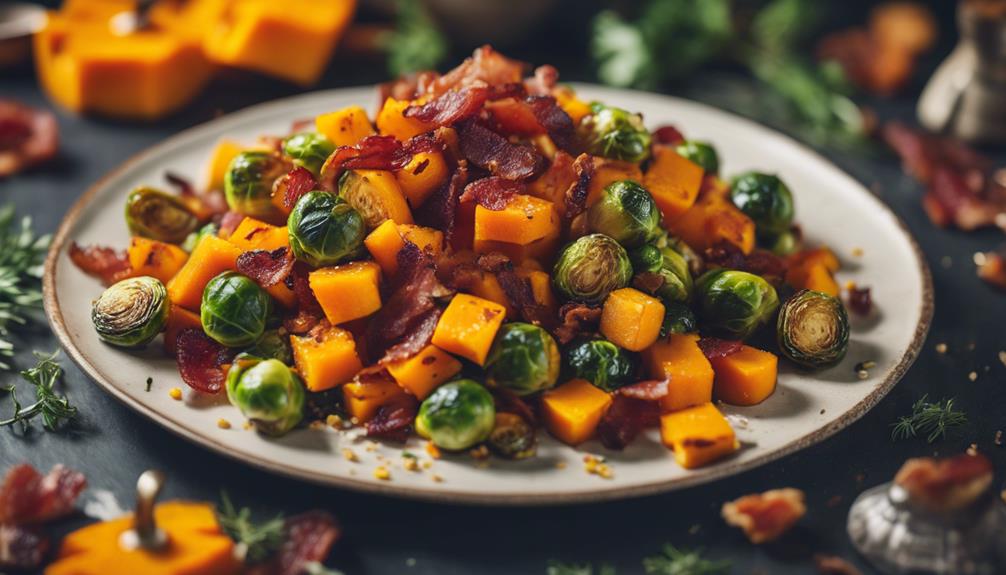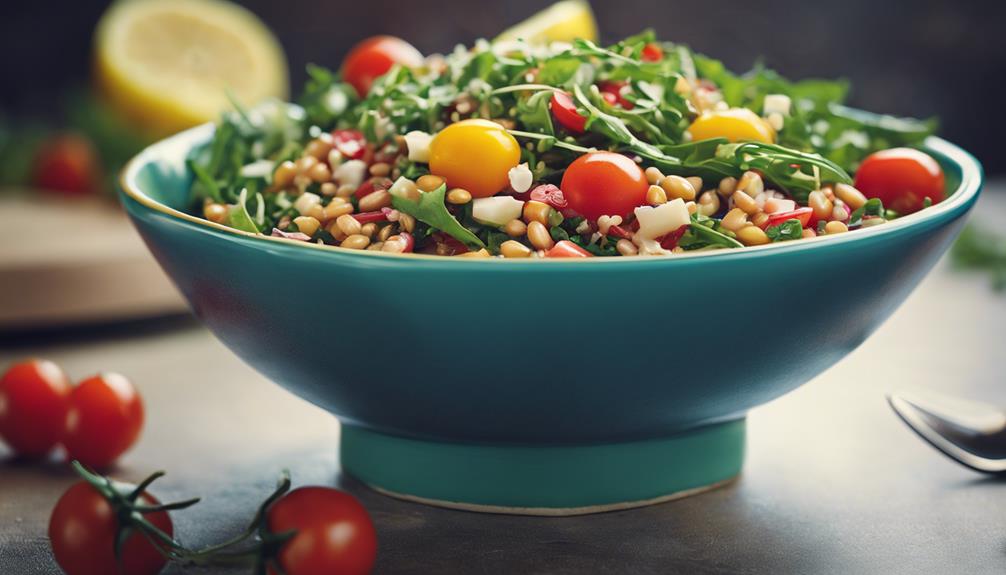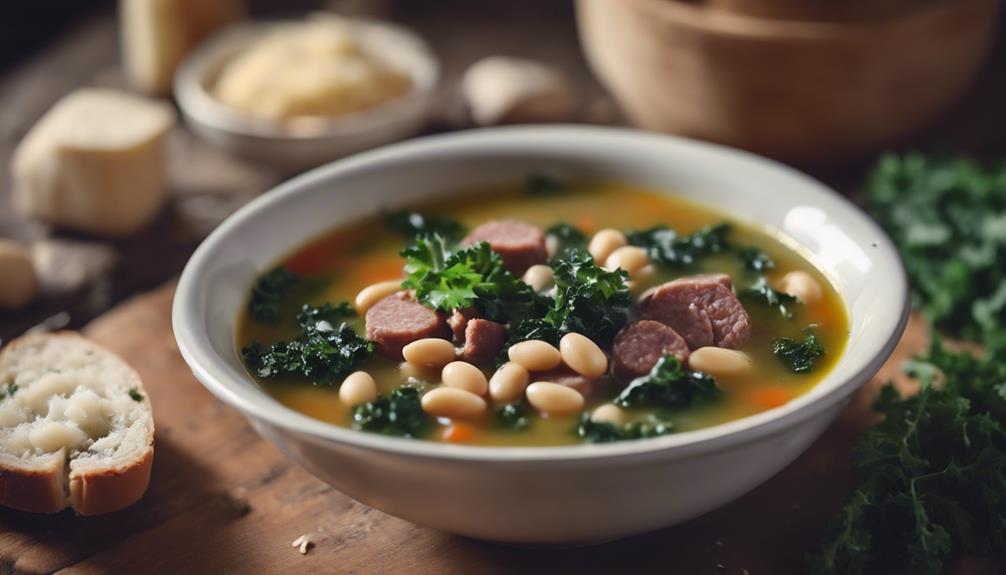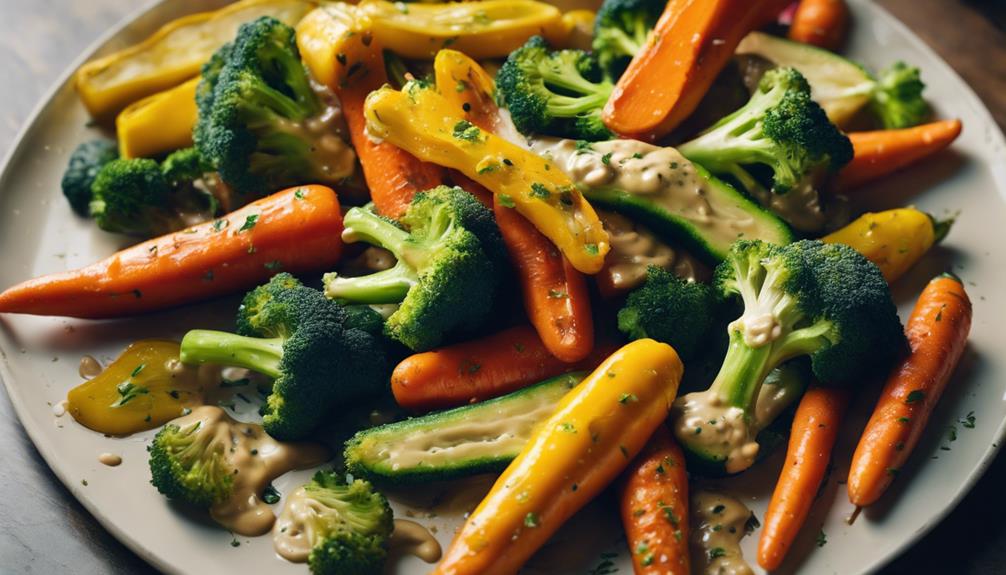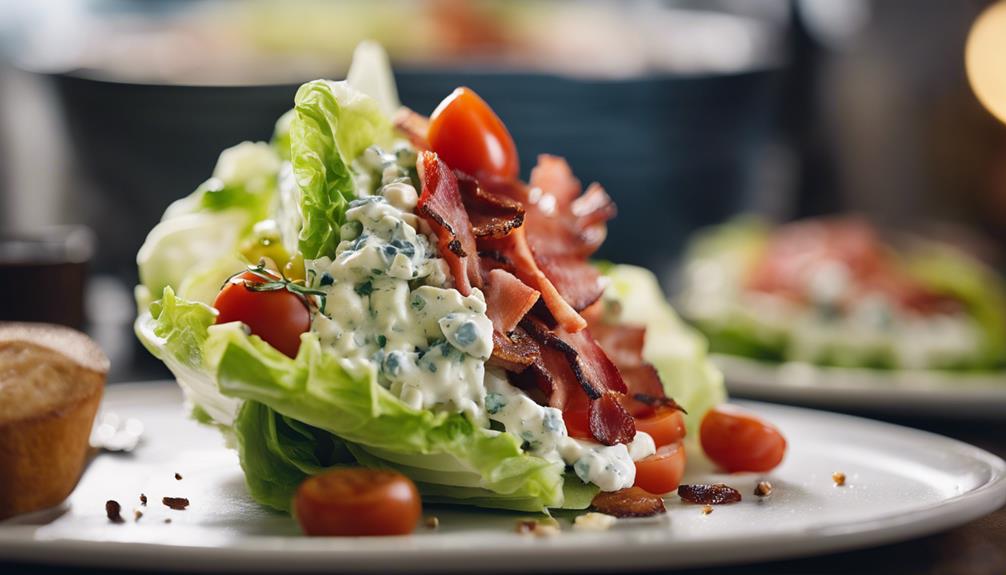Indulge in the perfect combination of health benefits and delicious flavors with the Butternut Squash Brussels Sprout Hash. This dish is packed with essential nutrients, such as high fiber, which can help with weight management and boost immunity. The roasted vegetables are cooked to perfection with the right oven temperatures, flavorful seasonings, and varying cooking times to bring out their natural goodness. Elevate the taste with ingredients like maple syrup, apple cider vinegar, and Dijon mustard for a well-balanced flavor profile. Enjoy this dish with baked salmon or customize it to your liking. Discover the versatility and nutritional benefits of this delightful side dish.
Key Takeaways
- Nutrient-dense: High in fiber, Vitamin A, and antioxidants for immunity and weight management.
- Versatile: Easily customizable with ingredient substitutions and dietary preferences.
- Flavorful: Enhanced with maple syrup, apple cider vinegar, and Dijon mustard for balance.
- Easy Preparation: Simple knife skills, roasting techniques, and time-saving options.
- Pairing Options: Perfect as a holiday side dish, with baked salmon, or varied toppings.
Benefits of Butternut Squash
Rich in essential nutrients, butternut squash offers a variety of health benefits that make it a valuable addition to your diet. Butternut squash is a nutrient-dense vegetable, packed with vitamins A and C, antioxidants, and fiber.
This healthy vegetable isn't only delicious but also a great source of essential nutrients. Its high fiber content supports digestive health and weight management. Additionally, the vitamins and antioxidants in butternut squash help boost immunity and promote healthy skin.
The potassium found in butternut squash is essential for heart health and regulating blood pressure. Whether roasted, pureed, or used in salads and side dishes, incorporating butternut squash into your meals can provide a flavorful and colorful twist while offering numerous health benefits.
Make this nutrient-packed vegetable a regular part of your diet to support your overall well-being.
Roasting Techniques for Vegetables
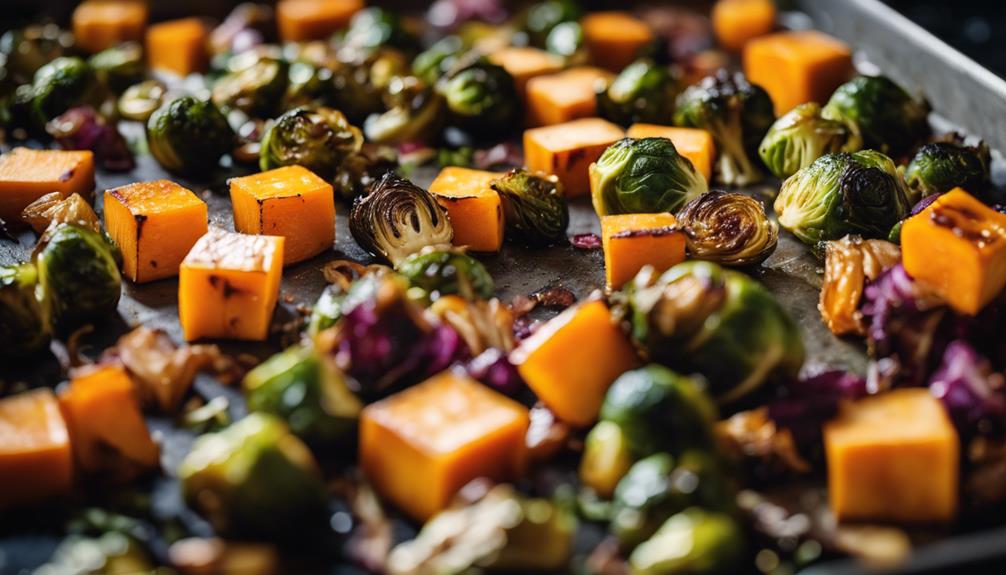
When roasting vegetables, the oven temperature settings play an essential role in achieving that perfect caramelization and browning. Seasoning and spices can elevate the flavors, while adjusting the cooking time guarantees the desired texture.
Mastering these roasting techniques will result in deliciously cooked vegetables every time.
Oven Temperature Settings
To achieve peak caramelization when roasting vegetables like butternut squash and Brussels sprouts, preheat the oven to 450 degrees Fahrenheit for best results. Here are some key tips for setting the oven temperature and ensuring your roasted vegetables turn out perfectly:
- High Temperature: Roasting at 450 degrees Fahrenheit helps achieve ideal caramelization, resulting in a flavorful and beautifully browned exterior on the vegetables.
- Avoid Overcrowding: To prevent steaming and ensure even cooking, refrain from overcrowding the baking sheet. Give the vegetables some space to roast properly.
- Separate Sheet Pans: For even cooking and caramelization, use separate sheet pans for each type of vegetable. This ensures that each vegetable cooks uniformly and develops a delicious flavor.
- Adjust Oven Temperature: If necessary, you can adjust the oven temperature to 425 degrees Fahrenheit, depending on the specific requirements of the vegetables you're roasting. Be mindful of the cooking times and adjust accordingly for the best results.
Seasoning and Spices
Moreover, enhance the flavor of your roasted vegetables like butternut squash and Brussels sprouts by carefully selecting and combining seasonings and spices.
When preparing your butternut squash and Brussels sprout hash, consider using common seasonings such as olive oil, salt, pepper, maple syrup, and even bacon fat for an added richness to your dish. These ingredients not only help in seasoning the vegetables but also contribute to the caramelization process during roasting.
Utilize roasting techniques like high heat, typically around 425-450 degrees Fahrenheit, to achieve that desired caramelization, enhancing the overall flavor profile of the dish.
To add depth and complexity, experiment with additional spices like garlic powder, cumin, or paprika. Moreover, explore different herb blends like rosemary, thyme, or sage to introduce a unique and aromatic twist to your roasted butternut squash and Brussels sprout hash.
Cooking Time Variation
For important caramelization and flavor development when roasting butternut squash and Brussels sprouts, consider roasting them separately.
When roasting Brussels sprouts, place them flat side down on a baking sheet and roast them for 15-18 minutes at 450°F to achieve a crispy texture.
Meanwhile, roast the butternut squash for 22-25 minutes at the same temperature for a tender consistency.
To enhance the flavors, drizzle maple syrup over the roasted vegetables before the final roasting to add a sweet and savory finish.
It's essential to avoid overcrowding the pan when roasting to prevent steaming and ensure even browning for a delicious side dish that's both healthy and flavorful.
Ingredient Preparation Tips
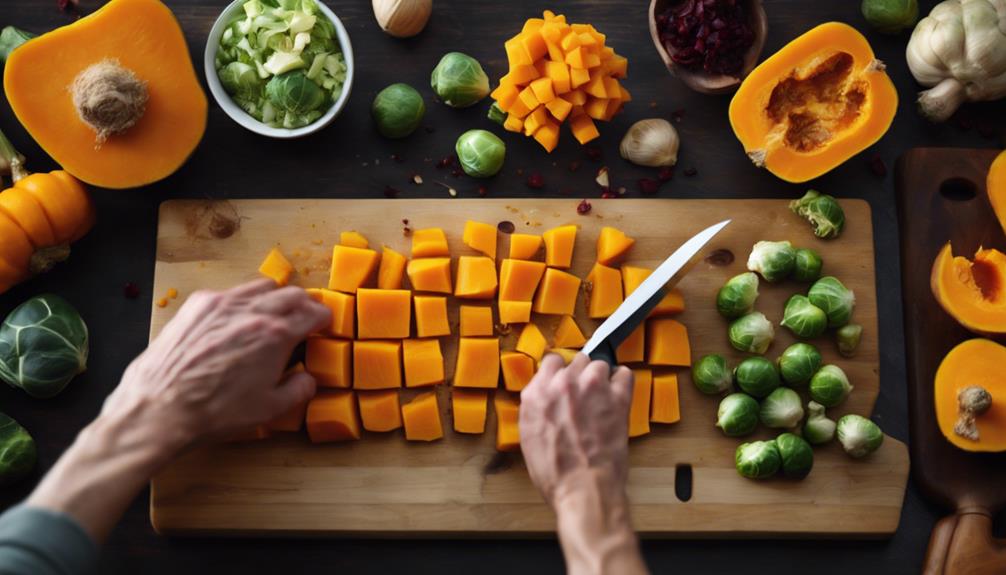
To guarantee success in preparing the ingredients for your Butternut Squash Brussel Sprout Hash, honing your knife skills is essential. Mastering precise cuts on the butternut squash and Brussels sprouts will enhance the dish's texture and cooking consistency.
Knife Skills
Efficiently prepare the butternut squash for the hash by using a Y peeler for easier peeling.
When it comes to knife skills for preparing the butternut squash, follow these steps:
- Start by cutting the ends: Trim off both ends of the squash for stability during the peeling and cutting process.
- Peel the squash: Use a Y peeler to effectively peel the skin off the butternut squash.
- Slice and remove seeds: Cut the squash in half lengthwise, then scoop out the seeds using a spoon.
- Dice the squash: After peeling, slicing, and deseeding, proceed to cube the butternut squash into evenly sized pieces.
Utilizing these knife skills will ensure that your butternut squash is properly prepped for the delicious Butternut Squash Brussels Sprout Hash.
Cooking Techniques
When preparing the Butternut Squash Brussels Sprout Hash, mastering effective cooking techniques for ingredient preparation is key to achieving a delicious outcome.
Start by tackling the butternut squash, easily done by cutting off the ends, peeling the skin, removing the seeds, and dicing it into uniform pieces. For a time-saving option, consider using pre-cubed squash available at many grocery stores.
The star ingredients, including Brussels sprouts, butternut squash, olive oil, salt, and pepper, come together to create a flavorful dish. To enhance texture and taste, consider adding pumpkin seeds and dried cranberries as customizable add-ons.
Remember, you can prep the ingredients up to 3 days ahead to make cooking day easier, but avoid preparing the dish too far in advance to maintain its freshness and best taste.
Dressing and Flavor Enhancements
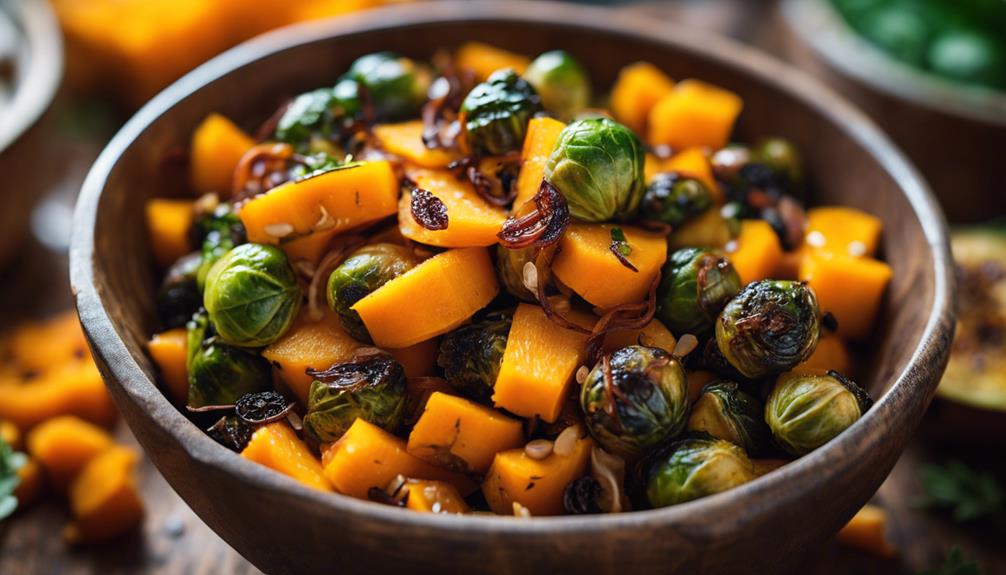
Enhance the flavors of your Butternut Squash Brussel Sprout Hash by preparing a dressing with extra virgin olive oil, maple syrup, apple cider vinegar, Dijon mustard, salt, and black pepper. This dressing will add a delightful balance of sweetness, tanginess, and savory notes to your dish.
Here's how each ingredient contributes to elevating the flavors:
- Maple Syrup: Enhances the natural sweetness of the roasted butternut squash and Brussels sprouts.
- Apple Cider Vinegar: Provides a subtle tangy kick, adding complexity to the overall flavor profile.
- Dijon Mustard: Helps emulsify the dressing and introduces a hint of sharpness that complements the roasted vegetables.
- Salt and Black Pepper: Seasonings that bring out the flavors of the ingredients and tie the dressing together harmoniously.
Serving Suggestions and Pairings
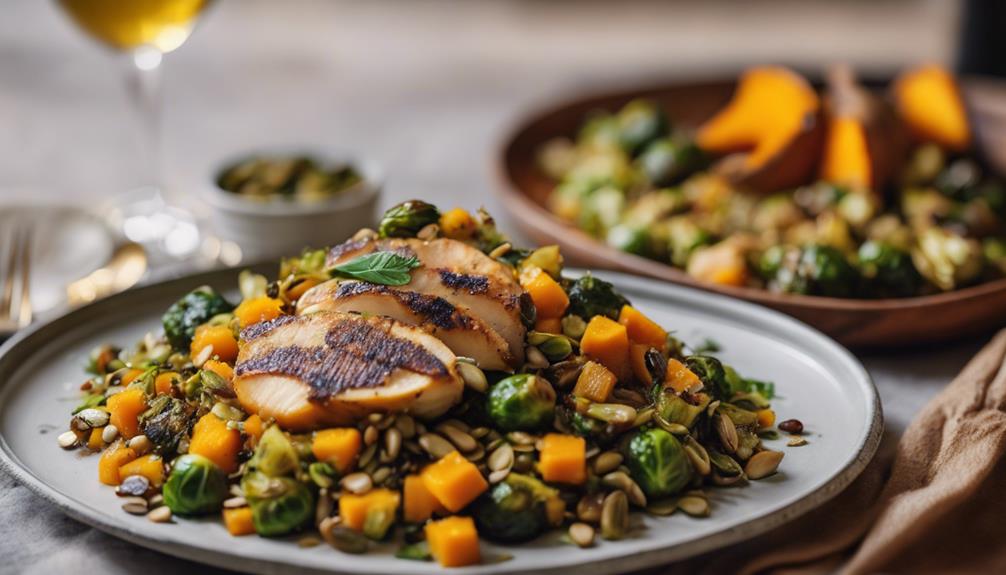
To elevate your dining experience, consider exploring various serving suggestions and pairings for your Butternut Squash Brussels Sprout Hash. This delightful side dish combines the earthy flavors of Brussels sprouts and butternut squash with the rich, smoky notes of bacon, creating a sweet and savory dish that's perfect for fall and winter meals.
For a complete and balanced meal, pair the hash with baked salmon, allowing the flavors to complement each other beautifully. Additionally, this hash can serve as a standout holiday side dish, impressing your guests with its unique blend of ingredients.
To enhance the flavors further, consider topping the dish with creamy feta or tangy goat cheese, drizzling it with a balsamic glaze, or garnishing it with fresh herbs for a burst of freshness. If you're looking to add a twist, try the Maple Roasted Butternut Squash with Brussels Sprouts and Bacon variation, which offers a delightful mix of sweet and savory notes.
This versatile side dish also allows for ingredient substitutions, such as sweet potatoes for butternut squash, walnuts for pecans, or omitting bacon for a vegetarian version.
Health Benefits of the Dish
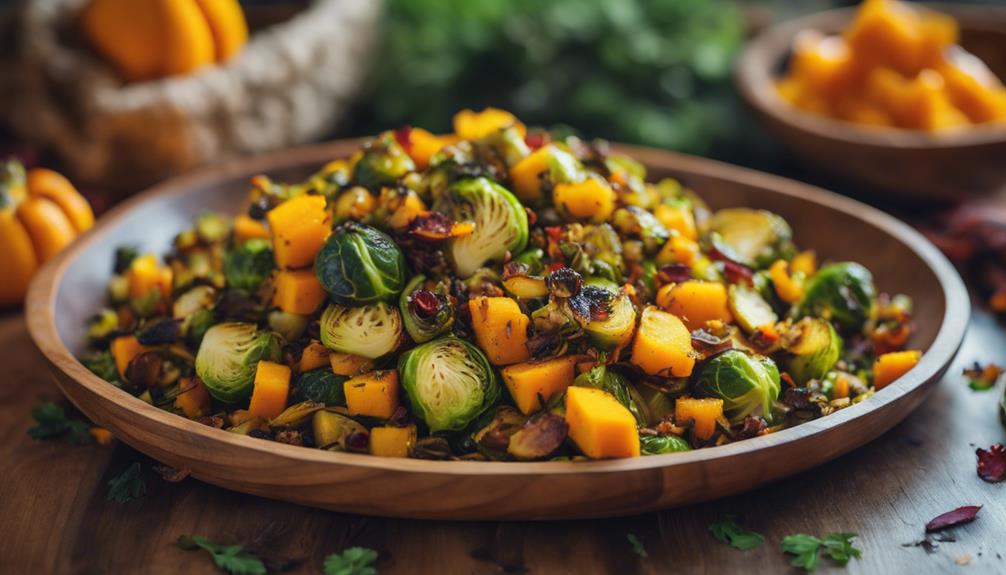
Incorporating Butternut Squash Brussels Sprout Hash into your diet can provide a range of health benefits due to the nutrient-rich combination of butternut squash and Brussels sprouts.
- High Vitamin A Content: Butternut squash is rich in vitamin A, offering about 457% of the recommended daily intake in just one cup, promoting good vision and immune function.
- Fiber for Digestion: Brussels sprouts are high in fiber, aiding in digestion and promoting a feeling of fullness, which can help with weight management.
- Heart Health Support: Both vegetables are low in calories but packed with essential nutrients like potassium and antioxidants, which can support heart health and reduce the risk of cardiovascular diseases.
- Boost to the Immune System: Consuming butternut squash and Brussels sprouts can boost the immune system due to their rich vitamin content and antioxidant properties, helping the body fight off illnesses effectively.
Frequently Asked Questions
What Is the Healthiest Way to Eat Brussel Sprouts?
To eat Brussels sprouts healthily, roast or steam them to retain nutrients. Avoid overcooking to keep texture and value. Raw in salads or cooked in dishes like stir-fries, Brussels sprouts add vitamins and fiber for a nutritious meal.
Are Brussel Sprouts the Healthiest Vegetable?
Yes, Brussels sprouts are incredibly healthy. They are packed with essential nutrients like vitamins C and K, fiber, and antioxidants. These veggies support digestion, heart health, and immune function, making them a top choice for wellness.
Are Brussel Sprouts as Healthy as Broccoli?
Brussels sprouts are a powerhouse veggie, rich in nutrients like vitamins K and C. They offer benefits similar to broccoli, supporting overall health. Including both in your diet can boost wellness and add variety to meals.
What Pairs Well With Brussels Sprouts?
You'll be surprised by how many flavors complement Brussels sprouts. Bacon, nuts, dried fruits, and maple syrup are just a few tasty options. Roast, sauté, or shred them raw for a delicious addition to salads, hashes, or stir-fries.
Can Miso Butter String Beans be a Healthy Alternative to Butternut Squash Brussel Sprout Hash as a Side Dish?
Looking for a healthy alternative side dish? Miso butter string beans could be the perfect option. Packed with flavor and nutrients, these beans are a great source of fiber and vitamins. Swap out the traditional hash for a lighter, but just as delicious, option.
Conclusion
To sum up, this butternut squash brussel sprout hash offers a flavorful and nutritious addition to any meal. Its unique combination of ingredients provides a satisfying and wholesome dish that's sure to please even the most discerning palate.
With careful preparation and attention to detail, this side dish can elevate any dining experience to a new level of culinary excellence.
So why not give it a try and savor the delicious flavors for yourself?
